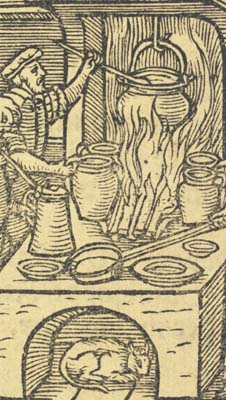
Early Cookery Books
![]()
By
today's standards, early cookbooks offered very little in the way of systematic,
step-by-step instruction. Quantities of ingredients were rarely given,
and directions were ambiguous. 15th and 16th century books on food mainly
described how to prepare ingredients with health and medicine in mind,
and reflected the medieval preference for heavily spiced foods in vinegar
based sauces.
In the 17th and 18th centuries, distinct national cuisines began to emerge, though the majority of published cookbooks record only the food habits of the wealthy. Alongside the growing body of published cookbooks was a rich oral tradition of shared family knowledge. Most middle class homemakers learned how to cook by watching their mothers and older sisters. Family traditions were often preserved by writing favorite recipes into household journals, which were passed down from one generation to the next.
From the 18th century onwards, an increasing number of cookery books were written by and for the growing middle class, which placed a new emphasis on how to achieve economy in the kitchen. Not until the 19th century did cookbooks begin to resemble the clear and comprehensive instruction manuals we use today.
 |
||

Copyright
© 2002 Division of Rare & Manuscript
Collections
2B Carl A. Kroch Library, Cornell University, Ithaca, NY, 14853
Phone Number: (607) 255-3530. Fax Number: (607) 255-9524
For
reference questions, send mail to:
rareref@cornell.edu
If you have questions or comments about the site, send mail to: webmaster.